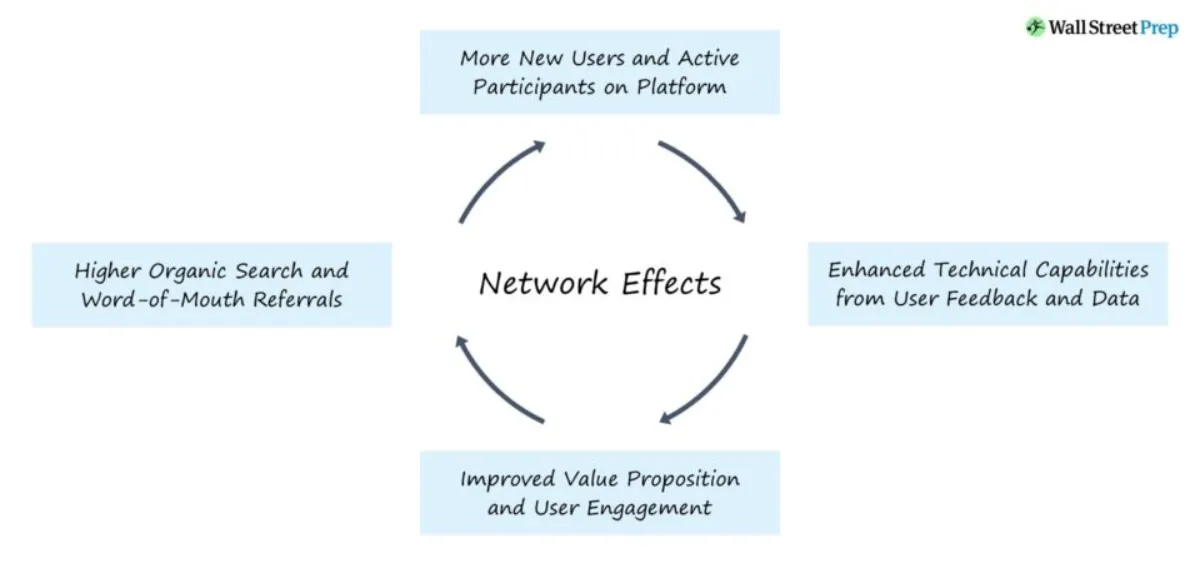Network Effects: The Key Behind Tech Companies

Technology companies are now the biggest and most successful businesses around. The main reason for this is something called "network effects." Network effects help tech companies grow rapidly and become extremely valuable. This concept is at the core of how many major tech firms plan their growth strategies.
This article takes a close look at network effects. It explains what they are and how they function. It covers the different types of network effects that exist. We also discuss the key advantages network effects provide to companies. Finally, we explore what the implications of network effects may be for the future of technology businesses.
Understanding Network Effects

Network effects occur when the value of a product or service increases as more people use it. This concept is not new, but its application in the tech industry has been transformative. Network effects can create a positive feedback loop, where increased adoption leads to higher value, which in turn attracts more users.
Types of Network Effects
- Direct Network Effects: These occur when the value of a service increases directly with the number of users. Social media platforms like Facebook and Twitter are prime examples, where the utility for each user grows as more friends and contacts join the network.
- Indirect Network Effects: These happen when the value of a product or service increases due to the growth of complementary products. For instance, the proliferation of apps on the Apple App Store enhances the value of owning an iPhone.
- Two-sided Network Effects: These are prevalent in platforms that connect two distinct user groups. A classic example is eBay, where the value to buyers increases as more sellers join the platform and vice versa.
- Local Network Effects: These are observed in services where the value is derived from the local concentration of users. Ride-sharing apps like Uber and Lyft benefit from this, as the availability of drivers in a specific area directly impacts the user experience.
The Role of Network Effects in Tech Companies

Tech companies leverage network effects to build robust ecosystems that are difficult for competitors to penetrate. This section will explore several key ways network effects contribute to the dominance of tech companies.
Scalability
Network effects facilitate rapid scaling. As more users join a platform, the cost per user decreases, and the platform becomes more attractive to additional users. This scalability is evident in companies like Google and Facebook, which have grown exponentially by harnessing network effects.

Competitive Advantage
Once a company achieves a critical mass of users, network effects create a formidable barrier to entry for competitors. The incumbent's value proposition becomes significantly stronger, making it challenging for new entrants to attract users away. For example, WhatsApp's massive user base makes it difficult for new messaging apps to gain traction.

User Engagement and Retention
Network effects enhance user engagement and retention. Users are more likely to stay on a platform where they find value through a large, active user base. This stickiness is crucial for tech companies aiming to build long-term relationships with their users. For instance, LinkedIn's value grows as professionals join, creating a rich network for jobseekers and recruiters.

Case Studies of Network Effects

Facebook's success is a textbook example of direct network effects. Initially, its value was derived from college students connecting with peers. As the user base expanded to include family, friends, and colleagues, the platform's utility skyrocketed. Today, Facebook's vast network of over 2.8 billion users creates immense value, making it an indispensable social tool.
Amazon
Amazon demonstrates both indirect and two-sided network effects. The platform becomes more valuable as more customers join, attracting a larger number of sellers who want to reach this growing customer base. This creates a diverse and extensive marketplace. Additionally, Amazon Web Services (AWS) benefits from indirect network effects, as the growth of cloud-based applications and services increases the value of AWS for its users. These network effects have made Amazon a leading player in both e-commerce and cloud computing.
Uber
Uber demonstrates local network effects. The value for riders increases with the availability of drivers in their vicinity. As Uber expands its driver network in a city, the service becomes more reliable and attractive to riders, creating a self-reinforcing growth cycle. This local concentration of drivers and riders enhances Uber's efficiency and user satisfaction.
LinkedIn demonstrates both direct and two-sided network effects. The value of the platform increases as more professionals join, enhancing networking opportunities and job searches for all users. Additionally, it connects job seekers with employers, making the platform more attractive to both parties as participation grows. This dual network effect has made LinkedIn the leading professional networking site, with over 700 million members worldwide.
Microsoft 365
Microsoft 365 benefits from indirect network effects. As more individuals and businesses adopt Office applications like Word, Excel, and PowerPoint, the demand for compatible products and services, such as third-party plugins and training programs, increases. This enhances the overall value of the Office Suite, creating a standard for productivity software that is hard for competitors to displace. The broad ecosystem of add-ons and a large user base reinforce its dominance in the market.
The Economics of Network Effects

Understanding the economics behind network effects is crucial for comprehending their impact on tech companies. This section delves into the cost structures, revenue models, and economic implications of network effects.
Cost Structures
Network effects can lead to significant cost advantages. The initial costs of developing a platform may be high, but the marginal cost of adding additional users is often low. This cost structure allows tech companies to achieve economies of scale, driving down the average cost per user and increasing profitability.
Revenue Models
Tech companies with strong network effects often adopt diverse revenue models. These can include subscription fees, advertising, transaction fees, and premium services. For example, LinkedIn generates revenue through premium subscriptions, job postings, and advertising, leveraging its extensive user network.
Economic Implications
The economic implications of network effects extend beyond individual companies. They can influence market dynamics, competition, and innovation. Markets dominated by network effects tend to have fewer, larger players, leading to potential monopolistic behavior. However, the innovation spurred by network effects can also drive significant economic growth and consumer benefits.
Challenges and Risks Associated with Network Effects

While network effects offer substantial advantages, they also come with challenges and risks. Tech companies must navigate these to maintain their growth and competitive edge.
Saturation
As a platform reaches saturation, the growth rate of new users may decline. Maintaining user engagement and finding new avenues for growth becomes challenging. Companies like Facebook have experienced slower user growth in mature markets and must innovate to sustain engagement.
Regulation
Regulatory scrutiny is a significant risk for tech companies benefiting from network effects. Concerns over data privacy, antitrust issues, and market dominance can lead to regulatory actions that impact business operations. For example, Google and Facebook have faced numerous regulatory challenges worldwide.
Platform Management
Managing a large platform with extensive network effects requires robust infrastructure and governance. Issues such as data security, content moderation, and user privacy become critical. Failure to address these effectively can erode user trust and diminish the value of the network.
The Future of Network Effects

As technology evolves, the nature and impact of network effects are likely to change. This section explores potential future developments and their implications for tech companies.
Emerging Technologies
Emerging technologies such as blockchain, artificial intelligence, and the Internet of Things (IoT) could redefine network effects. Blockchain, for example, offers decentralized network effects, where value is derived from a distributed network of users without a central authority.
New Market Opportunities
Network effects will continue to open new market opportunities. The growth of digital ecosystems, smart cities, and connected devices will create new platforms for network effects to flourish. Companies that can innovate and leverage these opportunities will be well-positioned for future success.
Sustainability
Sustainability concerns will influence the future of network effects. Companies will need to balance growth with environmental and social considerations. Sustainable practices can become a value driver, enhancing the appeal of platforms to environmentally conscious users.
Final Thoughts
Network effects are a key reason why many tech companies succeed. They allow these companies to grow quickly, gain advantages over competitors, and keep users engaged and loyal. However, network effects also create challenges and risks that companies must deal with carefully.
As technology keeps changing, the way network effects work will also evolve. This will create new opportunities, but will require new approaches from tech companies. Understanding and taking full advantage of network effects will remain very important for any tech company that wants to thrive in today's digital ecosystem.
Key Takeaways
| Section | Key Takeaways |
|---|---|
| Understanding Network Effects | Network effects make a product or service more valuable as more people use it. |
| Types of Network Effects | Direct: Value increases with more users (e.g., social media). Indirect: Value increases with complementary products (e.g., app stores). Two-sided: Connects two user groups (e.g., eBay). Local: Value from local user concentration (e.g., ride-sharing). |
| Role in Tech Companies | Help companies grow quickly, build strong defenses against competitors, and keep users engaged. |
| Case Studies | Facebook: Grows as more people join. Amazon: Benefits from many sellers and AWS users. Uber: More drivers attract more riders. |
| Economics | Costs: High initial cost, low cost per new user. Revenue: Subscriptions, ads, transaction fees. Impact: Shapes market competition and innovation. |
| Challenges | Saturation: Slower growth as markets mature. Regulation: Increased scrutiny from governments. Management: Need strong infrastructure and user trust. |
| Future | Tech: Blockchain, AI, IoT may change network effects. Opportunities: New markets like smart cities. Sustainability: Balancing growth with environmental concerns. |
| Final Thoughts | Network effects are crucial for tech company success but come with challenges. Understanding and leveraging them is key. |
Top Books on Network Effects
- "Platform Revolution: How Networked Markets Are Transforming the Economy--and How to Make Them Work for You" by Geoffrey G. Parker, Marshall W. Van Alstyne, and Sangeet Paul Choudary
- "Matchmakers: The New Economics of Multisided Platforms" by David S. Evans and Richard Schmalensee
- "The Business of Platforms: Strategy in the Age of Digital Competition, Innovation, and Power" by Michael A. Cusumano, Annabelle Gawer, and David B. Yoffie





